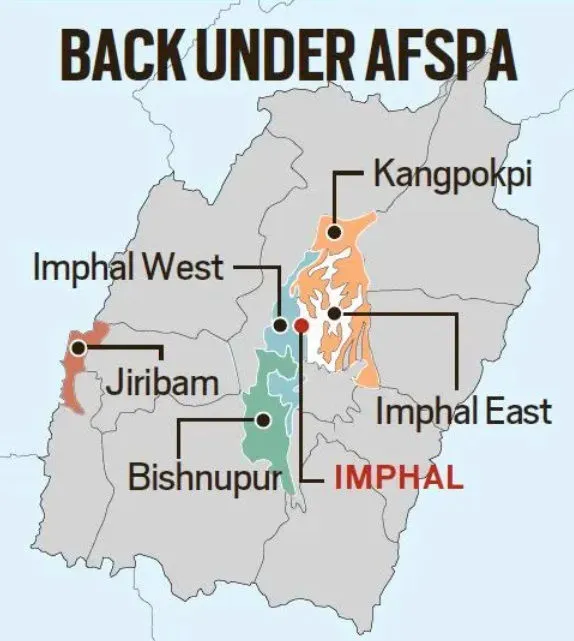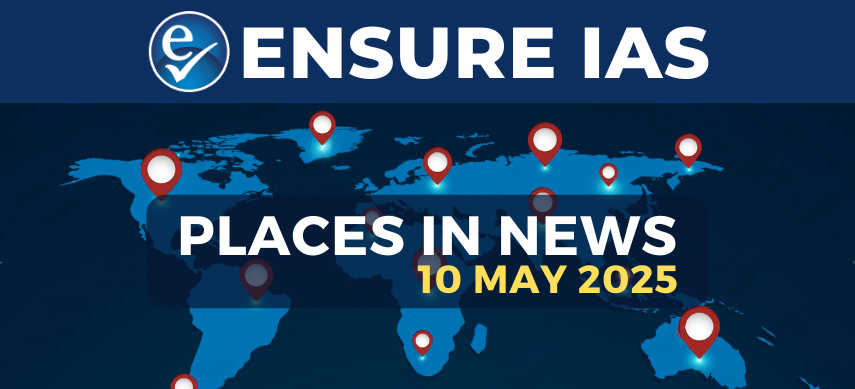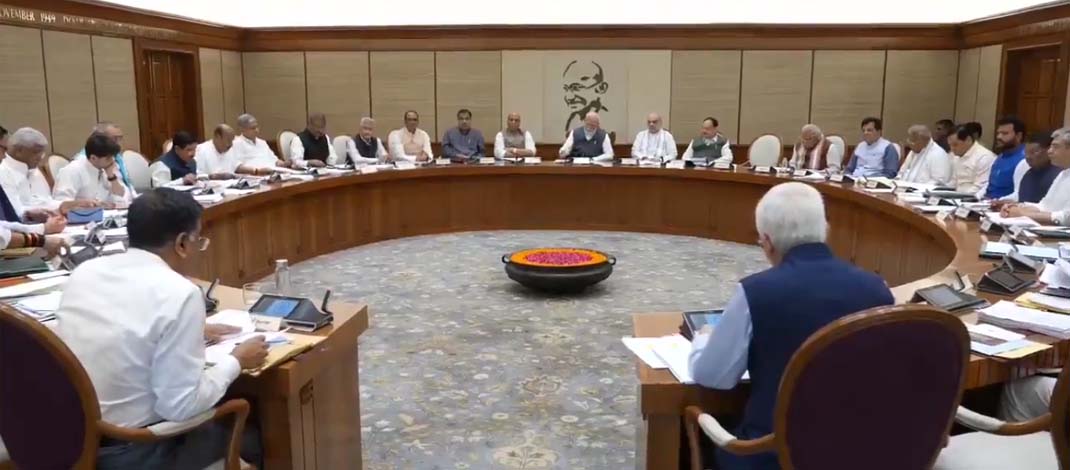- Courses
- GS Full Course 1 Year
- GS Full Course 2 Year
- GS Full Course 3 Year
- GS Full Course Till Selection
- Online Program
- GS Recorded Course
- NCERT (Recorded 500+ Hours)
- Polity Recorded Course
- Geography Recorded Course
- Economy Recorded Course
- AMAC Recorded Course
- Modern India, Post Independence & World History
- Environment Recoded Course
- Governance Recoded Course
- Science & Tech. Recoded Course
- International Relations and Internal Security Recorded Course
- Disaster Management Module Course
- Ethics Recoded Course
- Essay Recoded Course
- Current Affairs Recoded Course
- CSAT
- 5 LAYERED ARJUNA Mentorship
- Public Administration Optional
- ABOUT US
- OUR TOPPERS
- TEST SERIES
- FREE STUDY MATERIAL
- VIDEOS
- CONTACT US
Centre reimposes AFSPA in Manipur's 6 police station areas
Centre reimposes AFSPA in Manipur's 6 police station areas
17-11-2024
- Manipur has been facing ethnic violence for the past 19 months.
- However, the responses from both the state government and the Centre have been weak and largely ineffective.
- On 14th November 2024, the Union Home Ministry re-imposed Disturbed Area status under the Armed Forces (Special Powers) Act (AFSPA) in 6 police stations of the state.
- This includes areas in the Imphal valley, such as Sekmai, Lamsang, Lamlai, Moirang, Leimakhong, and Jiribam.
- Jiribam, located on the border with Assam, and other areas affected by the conflict, now fall under the reimposed AFSPA.

- While this reimposition may not cover a large area, it could worsen tensions in Manipur, where AFSPA has been highly controversial.
Background:
-
Ethnic Conflict:
- The conflict began when the Meitei community demanded Scheduled Tribe (ST) status, which was strongly opposed by the Kuki-Zomi communities.
- The violence has led to displacement and loss of life on both sides.
- Volunteers from both communities are now patrolling villages as part of local defence committees.
- Over 5,000 looted weapons are still missing, and the state’s police and army are not working together effectively to solve the problem.
-
AFSPA’s History:
- AFSPA was first imposed in 1958 in the Naga-dominated areas of Manipur.
- In the 1960s, it was extended to the Kuki-Zomi-dominated district of Churachandpur, and by 1979, it applied to the entire state.
- The act gives wide powers to the military, which has led to strong opposition from local people and rights groups.
Problems with AFSPA:
- The state government is treating the issue as simply a law-and-order problem, without addressing the deeper political, social, and historical issues behind the conflict.
- The government’s actions have been criticized for empty statements, blaming outsiders, imposing internet bans, and making vague promises of dialogue.
- This narrow approach does not help solve the underlying problems of ethnic divisions and socioeconomic inequalities.
- Reimposing AFSPA may lead to more military control, which could increase distrust between local communities and the military.
- AFSPA has a history of human rights violations, and many people see it as a blunt tool that doesn't address the real issues.
- Using force to solve the problem can make things worse and further alienate local people.
History of AFSPA in Manipur:
-
Role of AFSPA:
- AFSPA was first introduced in 1958 to control insurgency in Manipur, giving the military powers to arrest without a warrant, use force, and search properties.
- It was extended to more areas over time, especially after the rise of insurgent groups in the 1970s.
- In 2000, Irom Sharmila, a well-known activist, began a 16-year hunger strike against AFSPA, highlighting its human rights abuses.
- In 2004, a Jeevan Reddy Commission recommended that AFSPA be repealed, calling it “undesirable.” But the government didn’t act on this.
- Over time, the Centre has started rolling back AFSPA from some parts of the Northeast where militancy has reduced. However, Manipur remains an exception.
Current Problems in Manipur:
- Manipur, once one of the most prosperous states in the Northeast, now ranks among the poorest.
- It faces high levels of unemployment, poverty, and lack of development.
- The gap between the Meitei community (mainly in the Imphal Valley) and the Kuki-Zomi communities (mostly in the hills) has grown, making tensions worse.
- The conflict is not just about security but also about ethnic identity, historical grievances, and demands for better political representation.
- The government has failed to address these political issues and has focused only on military solutions, which is insufficient for long-term peace.
Alternatives to AFSPA:
- The government should give more autonomy to local communities to manage their affairs, ensuring that all ethnic groups have a voice in decision-making.
- Dialogue and peacebuilding should take priority over military action, as long-term peace depends on trust and cooperation between communities.
About Armed Forces (Special Powers) Act, 1958
About AFSPA
States Where AFSPA is in Effect
Disturbed Area
Controversial Provisions of AFSPA
|
Must Check: Best IAS Coaching In Delhi
UPSC Prelims Result 2024 Out: Expected Cut Off & Other Details, UPSC Prelims 2024 Answer with Explanation, Daily Prelims Quiz, Daily Current Affairs, MONTHLY CURRENT AFFAIRS TOTAL (CAT) MAGAZINE, Best IAS Coaching Institute in Karol Bagh, Best IAS Coaching Institute in Delhi, Daily Mains Question Answer Practice, ENSURE IAS UPSC Toppers, UPSC Toppers Marksheet, Previous Year Interview Questions, UPSC Syllabus



